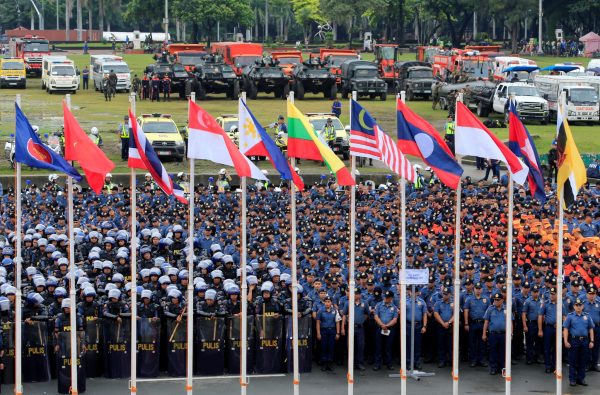Underlying the pursuit of competing foreign policy goals between the United States and China is a structural difference in strategy. While the United States focuses primarily on security through military cooperation, China combines its military efforts with a growing capacity and willingness to wield economic power.
As China grows increasingly able to weaponise its financial clout for security purposes, failure on the part of the US to craft a comprehensive economic response undermines the autonomy of Southeast Asian countries and diminishes US influence. The United States must realise that regional economic security is in its own best interest and work with ASEAN members to reduce financial vulnerabilities.
Within ASEAN, the South China Sea dispute exemplifies how China is targeting economic vulnerabilities to meet its foreign policy goals.
During the 2012 Scarborough Shoal standoff, Beijing suddenly demanded payment from the Philippines for an infrastructure loan, bankrupted growers by restricting banana imports and issued an advisory against travel to the Philippines.
In 2014, anti-China riots broke out in Vietnam after China parked an oil rig in contested waters, leading Beijing to reduce tourism and threaten to suppress investment if Hanoi did not swiftly halt protests.
Meanwhile, ASEAN solidarity following the UN Convention on the Law of the Sea decision against China’s maritime claims in the South China Sea has been repeatedly thwarted by Cambodia, under economic pressure from China.
The risk of financial retribution against Southeast Asian countries grows as China increases its regional economic power. Calculating the mean of China’s shares of trade with each ASEAN country reveals that China represents 20 per cent of the average export market and 22 per cent of the average import market, up from 7 per cent and 13 per cent in 2006. ASEAN is particularly susceptible to coercion because it is one of the most trade-dependent regions in the world, with merchandise exports over US$1.2 trillion, or 54 per cent of its total GDP.
As Beijing further expands its political influence through projects like the Belt and Road Initiative (BRI) and the Asian Infrastructure Investment Bank (AIIB), expect economic leveraging to be a persistent feature of China’s strategy.
Rather than pursue a narrow approach to the region, the United States must develop a multidimensional strategy that reinforces regional economic security, provides for autonomous decision-making and reduces financial dependence on China.
First, the United States should increase economic engagement with Southeast Asia. While China has increased its economic presence since 2006, the United States fell from 16 per cent of exports and 7 per cent of imports in the mean ASEAN country to 10 per cent of exports and 6 per cent of imports.
Though its ‘America First’ policy may constrain deal-making, the White House could renegotiate the Trans-Pacific Partnership (TPP) deal in a way that affords greater protection for US workers. If this proves untenable, the United States should seek to establish bilateral trade deals, which President Trump prefers. Greater economic engagement would further engrain economic relationships, promote long-term commercial interests in an area of dynamic growth and limit the growing asymmetry between US–ASEAN and China–ASEAN trade.
Second, the United States should encourage alternate opportunities for trade and investment. Despite rapid individual growth within ASEAN, intra-regional trade fell 2 per cent between 2013–2016. The United States should help facilitate the implementation of ASEAN’s Economic Community integration plan to create a single market and production base. International coordination to increase funding for the Asian Development Bank’s (ADB) ASEAN Infrastructure Fund would also meet a critical need.
The United States must not impede Japan’s continued efforts to push for the TPP and support efforts to counteract China by boosting FDI. It should also seek to further integrate India into regional trade, especially as China seeks access to the Indian Ocean.
Third, the United States should work with partners like Japan, the ADB, and the World Bank to reverse diminishing aid trends and increase official development assistance (ODA) to countries that need it. A lack of aid leaves a vacuum for China to fill. In the Philippines for example, Duterte is requesting an additional US$2.7 billion in Chinese infrastructure loans after last October’s US$9 billion, despite Beijing’s poor track record for infrastructure aid there.
Thailand, Malaysia and Indonesia receive even less aid than the Philippines, and China is now demanding the ability to seize assets from governments that default on loan repayments. All this suggests that now is a good time to attach fewer strings to larger volumes of US ODA. Washington should also consider active membership in the AIIB to shape its development and reduce reliance on bilateral Chinese infrastructure funding.
Finally, the United States should protect against China’s attempts to monopolise global production of important goods. As demonstrated by rapidly withholding rare earth exports from Japan in 2010, Beijing is willing to deny key materials from markets it has cornered. While the WTO can attempt to uphold trade regulations in case of a dispute, foresight and cooperation are required to prevent future exploitation of export monopolies.
The United States’ capacity to shape the world order was born out of long time horizons and predictive big picture thinking. Now that the United States is faced with a rising power that has its own dreams of global architecture and its own ideas of how to achieve such dreams, the same country whose wealth was foundational to the modern international system cannot afford to forget the importance of money.
Jacob Merkle is Research Intern with Pacific Forum, a subsidiary of the Centre for Strategic and International Studies.

